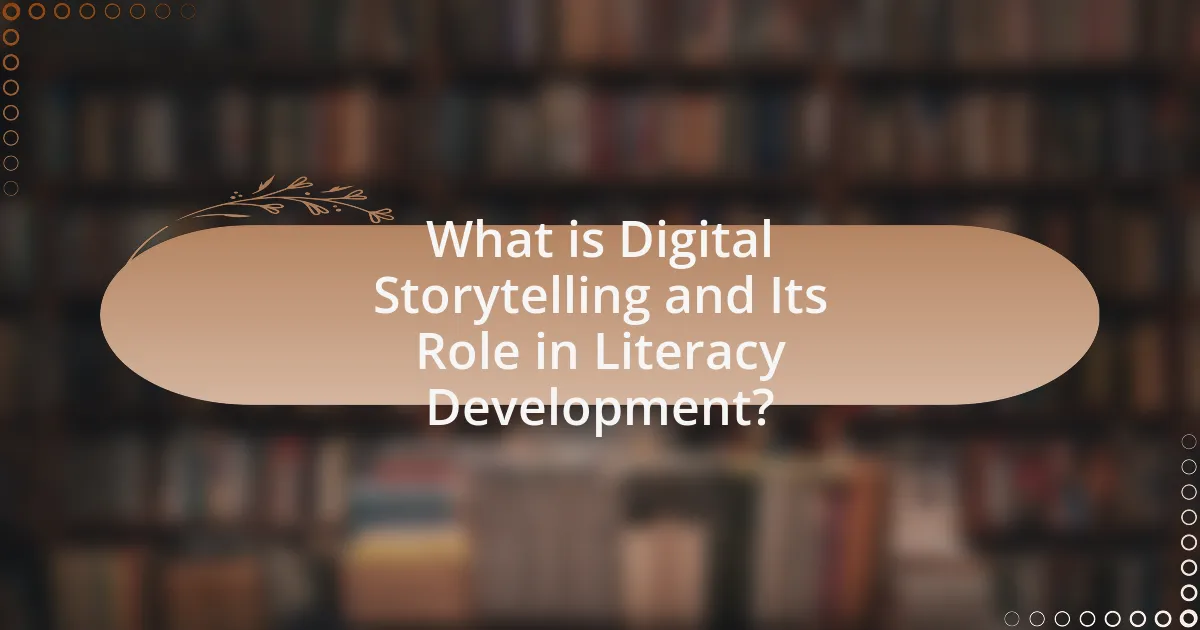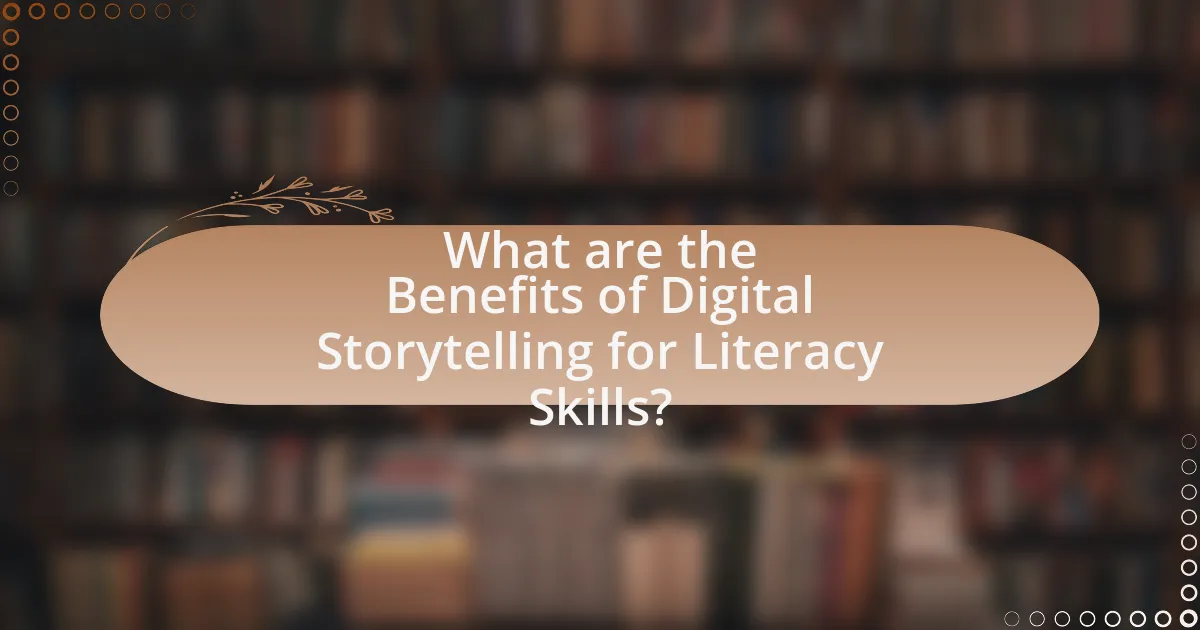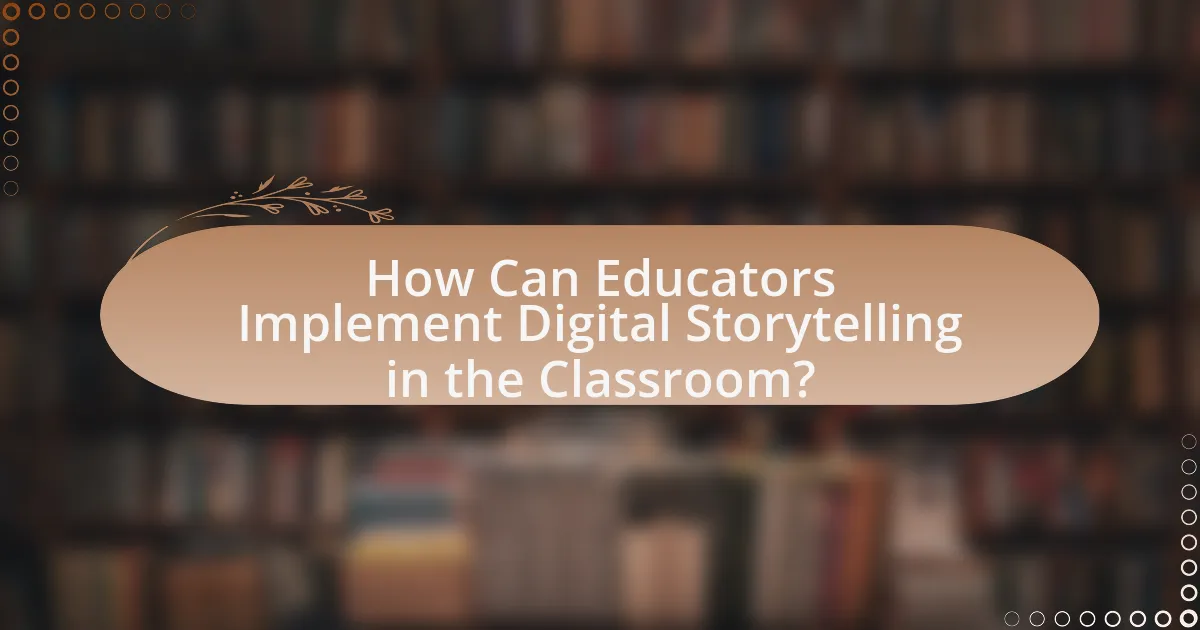Digital storytelling is the practice of using digital tools to create and share narratives, integrating multimedia elements such as text, images, audio, and video. This method significantly enhances literacy skills by engaging learners in creative expression, improving reading comprehension, writing proficiency, and critical thinking. The article explores the differences between digital and traditional storytelling, the technologies involved, and the benefits of digital storytelling for literacy development. It also addresses how educators can implement digital storytelling in the classroom, the challenges they may face, and practical tips for effective integration into literacy programs.

What is Digital Storytelling and Its Role in Literacy Development?
Digital storytelling is the practice of using digital tools to create and share narratives, combining multimedia elements such as text, images, audio, and video. This approach plays a significant role in literacy development by engaging learners in the storytelling process, enhancing their reading and writing skills through creative expression. Research indicates that digital storytelling fosters critical thinking and comprehension, as students must analyze and synthesize information to construct their narratives. For instance, a study by Robin (2008) highlights that students who engage in digital storytelling demonstrate improved narrative skills and greater motivation to read and write, thereby reinforcing the connection between digital storytelling and literacy advancement.
How does digital storytelling differ from traditional storytelling?
Digital storytelling differs from traditional storytelling primarily in its use of technology to enhance narrative delivery. While traditional storytelling relies on oral or written forms, digital storytelling incorporates multimedia elements such as video, audio, images, and interactive features, allowing for a more immersive experience. Research indicates that this multimedia approach can significantly engage audiences, as evidenced by a study published in the Journal of Educational Technology & Society, which found that students who participated in digital storytelling projects demonstrated improved literacy skills and higher levels of engagement compared to those involved in traditional storytelling methods.
What technologies are commonly used in digital storytelling?
Common technologies used in digital storytelling include video editing software, animation tools, audio recording equipment, and interactive platforms. Video editing software like Adobe Premiere Pro and Final Cut Pro allows creators to compile and edit visual narratives effectively. Animation tools such as Adobe After Effects and Toon Boom facilitate the creation of animated stories, enhancing engagement. Audio recording equipment, including microphones and sound editing software like Audacity, ensures high-quality sound, which is crucial for storytelling. Interactive platforms like Twine and StoryMapJS enable users to create immersive, nonlinear narratives, fostering deeper audience interaction. These technologies collectively enhance the storytelling process, making it more dynamic and accessible.
How do these technologies enhance the storytelling experience?
Technologies enhance the storytelling experience by providing interactive and immersive elements that engage audiences more deeply. For instance, digital platforms allow for multimedia integration, combining text, audio, and visuals, which caters to diverse learning styles and keeps users engaged. Research shows that interactive storytelling can improve comprehension and retention; a study by the University of Southern California found that participants in interactive narratives scored 20% higher on recall tests compared to traditional storytelling methods. This integration of technology not only captivates the audience but also fosters critical thinking and creativity, essential components of literacy development.
Why is literacy important in the context of digital storytelling?
Literacy is crucial in the context of digital storytelling because it enables individuals to effectively interpret, create, and engage with multimedia narratives. Digital storytelling often combines text, images, audio, and video, requiring a diverse set of literacy skills to understand and produce content. Research indicates that digital literacy, which encompasses the ability to navigate and critically assess digital media, is essential for meaningful participation in today’s information-rich society. For instance, a study by the Pew Research Center found that 87% of teachers believe that digital literacy is as important as traditional literacy in preparing students for future success. This highlights the necessity of literacy in navigating the complexities of digital storytelling, ensuring that individuals can both consume and contribute to digital narratives effectively.
What are the key literacy skills that digital storytelling can improve?
Digital storytelling can improve key literacy skills such as reading comprehension, writing proficiency, critical thinking, and digital literacy. Reading comprehension is enhanced as individuals engage with narratives, analyze story structures, and interpret themes. Writing proficiency improves through the creation of scripts, storyboards, and multimedia content, fostering better organization and expression of ideas. Critical thinking is developed as learners evaluate sources, make decisions about content, and reflect on their storytelling choices. Digital literacy is strengthened as users navigate various digital tools and platforms, learning to create and share stories effectively. Research indicates that these skills are vital for academic success and effective communication in the digital age.
How does digital storytelling engage different learning styles?
Digital storytelling engages different learning styles by incorporating visual, auditory, and kinesthetic elements that cater to diverse preferences. Visual learners benefit from graphics and animations, auditory learners engage with narrative voiceovers and sound effects, while kinesthetic learners can participate through interactive storytelling activities. Research indicates that multimedia presentations, such as those used in digital storytelling, enhance retention and understanding across various learning styles, as supported by studies like Mayer’s Cognitive Theory of Multimedia Learning, which emphasizes the effectiveness of combining words and pictures to improve learning outcomes.

What are the Benefits of Digital Storytelling for Literacy Skills?
Digital storytelling enhances literacy skills by engaging learners in creative expression and critical thinking. This method allows individuals to combine visual, auditory, and textual elements, fostering a deeper understanding of narrative structure and language use. Research indicates that students who participate in digital storytelling demonstrate improved reading comprehension and writing skills, as they actively construct and share their stories. A study by Robin (2008) found that digital storytelling not only boosts students’ motivation but also enhances their ability to articulate thoughts and ideas effectively, leading to greater literacy development.
How does digital storytelling foster creativity in learners?
Digital storytelling fosters creativity in learners by allowing them to express their ideas through various multimedia formats, such as text, images, audio, and video. This interactive approach encourages learners to think critically and imaginatively as they craft narratives, enabling them to explore different perspectives and storytelling techniques. Research indicates that engaging in digital storytelling enhances creative thinking skills, as it requires learners to make decisions about content, structure, and presentation, ultimately leading to a deeper understanding of the material. For instance, a study by Robin (2008) highlights that students who participate in digital storytelling projects demonstrate increased engagement and creativity compared to traditional writing assignments.
What role does imagination play in literacy development through storytelling?
Imagination plays a crucial role in literacy development through storytelling by enhancing cognitive engagement and fostering creativity. When individuals engage with stories, their imagination allows them to visualize characters, settings, and events, which deepens comprehension and retention of the material. Research indicates that imaginative storytelling can improve vocabulary acquisition and narrative skills, as it encourages learners to think critically and make connections between the text and their own experiences. For instance, a study published in the Journal of Educational Psychology found that children who participated in imaginative storytelling activities demonstrated significantly higher literacy skills compared to those who did not, highlighting the importance of imagination in the learning process.
How can creativity lead to improved writing skills?
Creativity enhances writing skills by fostering original thought and encouraging unique expression. When writers engage in creative processes, they explore diverse perspectives and ideas, which can lead to more compelling narratives and richer vocabulary. Research indicates that creative writing exercises, such as storytelling and improvisation, significantly improve language proficiency and critical thinking. A study published in the Journal of Creative Behavior found that participants who practiced creative writing demonstrated a 30% increase in their overall writing quality compared to those who did not engage in such activities. This evidence supports the notion that creativity not only enriches content but also refines technical writing abilities.
What impact does digital storytelling have on comprehension and retention?
Digital storytelling significantly enhances comprehension and retention by engaging multiple senses and fostering emotional connections. Research indicates that narratives presented through digital mediums, such as videos or interactive platforms, improve information retention by up to 65% compared to traditional text-based methods. This is supported by a study published in the Journal of Educational Psychology, which found that students who engaged with digital storytelling demonstrated higher levels of understanding and recall of the material. The combination of visual, auditory, and interactive elements in digital storytelling creates a richer learning experience, making it easier for learners to process and remember information.
How does visual storytelling aid in understanding complex concepts?
Visual storytelling aids in understanding complex concepts by simplifying information through visual elements, which enhance cognitive processing. Research indicates that visuals can increase retention rates by up to 65% compared to text alone, as demonstrated in studies by the University of California, which found that people remember 80% of what they see and do, versus only 20% of what they read. This effectiveness stems from the brain’s ability to process images faster than text, allowing for quicker comprehension and deeper engagement with the material. Additionally, visual storytelling can illustrate relationships and hierarchies within complex ideas, making abstract concepts more tangible and relatable.
What evidence supports the effectiveness of digital storytelling in literacy education?
Digital storytelling has been shown to significantly enhance literacy education through various studies. Research conducted by Robin (2008) indicates that digital storytelling improves students’ writing skills, as it encourages them to engage in narrative construction and critical thinking. Additionally, a study by Ohler (2008) found that students who participated in digital storytelling projects demonstrated increased motivation and engagement in their learning processes, leading to better comprehension and retention of material. Furthermore, a meta-analysis by Kearney and Hyle (2008) revealed that digital storytelling fosters collaboration and communication skills among students, which are essential components of literacy. These findings collectively support the effectiveness of digital storytelling in enhancing literacy education.

How Can Educators Implement Digital Storytelling in the Classroom?
Educators can implement digital storytelling in the classroom by integrating technology tools that allow students to create and share their narratives. This can be achieved through platforms like Adobe Spark, Storybird, or WeVideo, which provide user-friendly interfaces for students to combine text, images, and audio. Research indicates that digital storytelling enhances literacy skills by promoting engagement and creativity, as evidenced by a study published in the Journal of Educational Technology & Society, which found that students who participated in digital storytelling projects demonstrated improved writing skills and increased motivation to read. By incorporating these tools and methodologies, educators can effectively foster a more interactive and enriching learning environment.
What are the best practices for integrating digital storytelling into literacy programs?
The best practices for integrating digital storytelling into literacy programs include providing training for educators, incorporating diverse digital tools, and fostering collaboration among students. Training educators ensures they are equipped to guide students effectively in using technology for storytelling. Utilizing a variety of digital tools, such as video editing software and online platforms, enhances engagement and creativity in storytelling. Collaboration among students promotes peer learning and critical thinking, as they share ideas and feedback on each other’s stories. Research by Robin (2008) highlights that these practices not only improve literacy skills but also enhance students’ motivation and engagement in learning.
How can teachers assess student progress in digital storytelling?
Teachers can assess student progress in digital storytelling through a combination of rubrics, peer reviews, and reflective journals. Rubrics provide clear criteria for evaluating elements such as creativity, narrative structure, and technical skills, allowing teachers to quantify student performance. Peer reviews encourage collaboration and critical thinking, as students provide feedback on each other’s work, fostering a deeper understanding of storytelling techniques. Reflective journals enable students to articulate their learning process and self-assess their growth, offering insights into their engagement and comprehension of digital storytelling concepts. These assessment methods are supported by research indicating that structured feedback and self-reflection significantly enhance learning outcomes in creative projects.
What resources are available for educators to get started with digital storytelling?
Educators can access various resources to get started with digital storytelling, including online platforms, toolkits, and professional development courses. Websites like Storybird and WeVideo provide user-friendly interfaces for creating digital stories, while the Digital Storytelling Association offers guidelines and best practices. Additionally, the book “Digital Storytelling: A Creator’s Guide to Interactive Entertainment” by Carolyn Handler Miller serves as a comprehensive resource for understanding the principles of digital storytelling. These resources equip educators with the necessary tools and knowledge to effectively implement digital storytelling in their classrooms, enhancing students’ literacy skills through engaging and creative narratives.
What challenges might educators face when using digital storytelling?
Educators may face several challenges when using digital storytelling, including technological barriers, varying levels of digital literacy among students, and time constraints. Technological barriers can arise from inadequate access to devices or reliable internet, which limits students’ ability to engage with digital storytelling tools effectively. Additionally, students may possess differing levels of digital literacy, making it difficult for educators to ensure that all learners can navigate the storytelling platforms proficiently. Time constraints also pose a significant challenge, as educators must balance the integration of digital storytelling with existing curricula and assessment requirements, often leading to insufficient time for both instruction and project completion.
How can these challenges be overcome to enhance literacy skills?
To overcome challenges in enhancing literacy skills through digital storytelling, educators can implement targeted training programs for teachers that focus on integrating technology effectively into literacy instruction. Research indicates that professional development in digital tools can significantly improve teachers’ confidence and competence, leading to better student engagement and learning outcomes. For instance, a study by the International Society for Technology in Education found that teachers who received training in digital storytelling techniques reported a 30% increase in student participation and a 25% improvement in literacy skills among their students. By equipping educators with the necessary skills and resources, the barriers to effective literacy instruction can be reduced, ultimately fostering a more engaging and effective learning environment.
What are some practical tips for effective digital storytelling in literacy education?
Effective digital storytelling in literacy education can be enhanced by incorporating multimedia elements, encouraging collaboration, and focusing on narrative structure. Utilizing images, audio, and video engages students and caters to diverse learning styles, which has been shown to improve comprehension and retention. Collaborative projects foster peer interaction and critical thinking, allowing students to share ideas and refine their storytelling skills. Additionally, emphasizing a clear narrative structure helps students organize their thoughts and enhances their ability to convey messages effectively, as supported by research indicating that structured storytelling improves literacy outcomes.